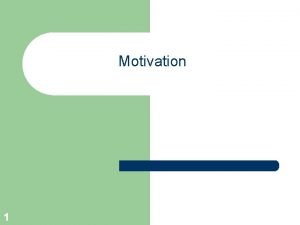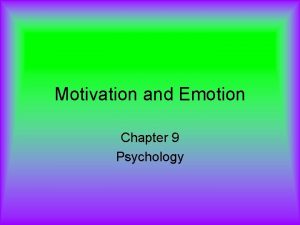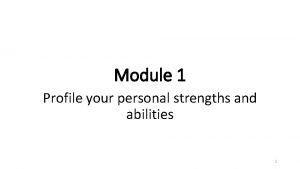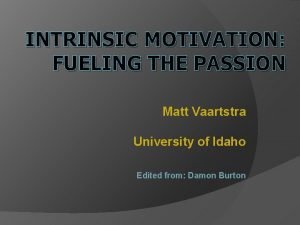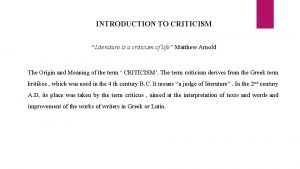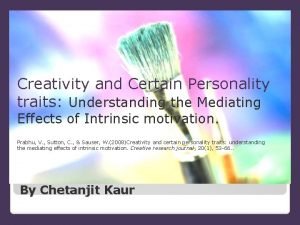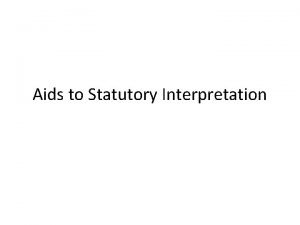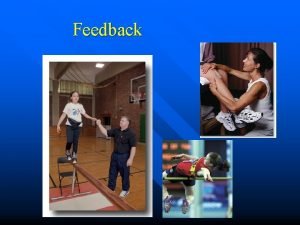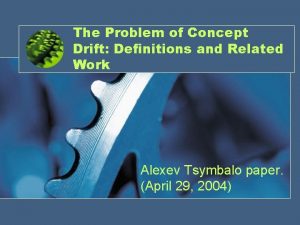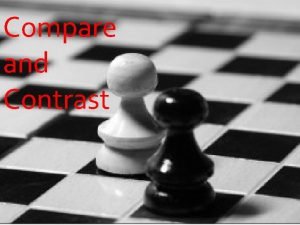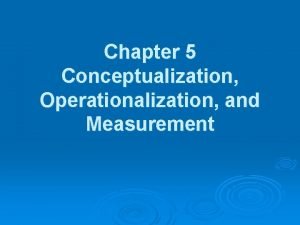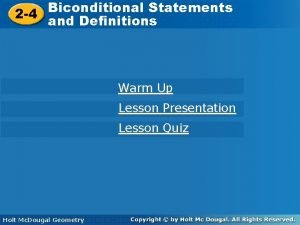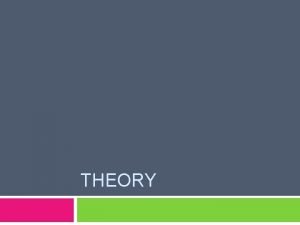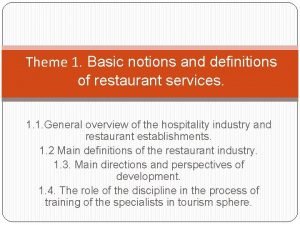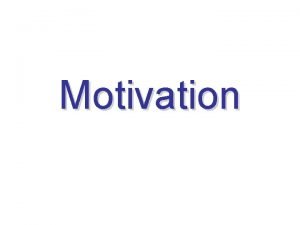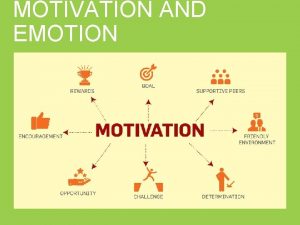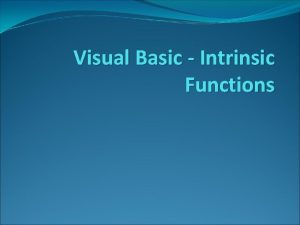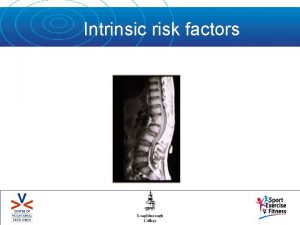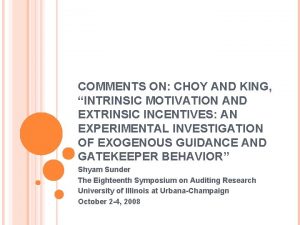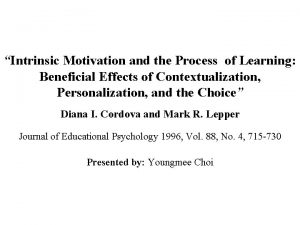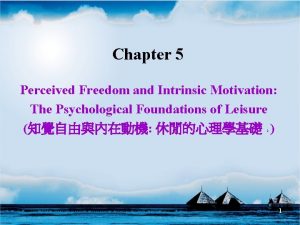Motivation and Activity Plan Definitions of Motivation Intrinsic









































- Slides: 41

Motivation and Activity

Plan • Definitions of Motivation • Intrinsic and extrinsic motivation • Process of Motivation • Theories about motivation • Self-efficacy and Social Motives • Maslow’s Hierarchy of Needs • Hunger and Eating • Activity theory

Definitions of Motivation • Motivation describes the wants or needs that direct behavior toward a goal. • “Motivation is a process where by needs instigate behavior directed towards the goals that can satisfy those needs” (Joe Kelly). • “Motivation means a process of stimulating people to action to accomplish the desired goals” (W. G. Scot). • “Motivation is the act of stimulating someone or oneself to get a desired course of action, to push the right button to get a desired results” (Michael J. Jucius) • Most psychological theories hold that motivation exists purely within the individual, but socio-cultural theories express motivation as an outcome of participation in actions and activities within the cultural context of social groups.

Intrinsic and extrinsic motivation Intrinsic motivation comes from within the individual, while extrinsic motivation comes from outside the individual.

Research suggests that when something we love to do, like icing cakes, becomes our job, our intrinsic and extrinsic motivations to do it may change.

Process of Motivation

Theories about motivation James theorized that behavior was driven by a number of instincts, which aid survival. From a biological perspective, an instinct is a species-specific pattern of behavior. James proposed several dozen special human instincts. A mother’s protection of her baby, the urge to lick sugar, and hunting prey were among the human behaviors proposed as true instincts during James’s era. This view—that human behavior is driven by instincts—received a fair amount of criticism because of the undeniable role of learning in shaping all sorts of human behavior. William James proposed the instinct theory of motivation, asserting that behavior is driven by Instincts.

• Another early theory of motivation proposed that the maintenance of homeostasis is particularly important in directing behavior. homeostasis is the tendency to maintain a balance, or optimal level, within a biological system. In a body system, a control center (which is often part of the brain) receives input from receptors (which are often complexes of neurons). The control center directs effectors (which may be other neurons) to correct any imbalance detected by the control center.

• According to the drive theory of motivation, deviations from homeostasis create physiological needs. • These needs result in psychological drive states that direct behavior to meet the need and, ultimately, bring the system back to homeostasis. For example, if it’s been a while since you ate, your blood sugar levels will drop below normal. This low blood sugar will induce a physiological need and a corresponding drive state (i. e. , hunger) that will direct you to seek out and consume food. Eating will eliminate the hunger, and, ultimately, your blood sugar levels will return to normal. Interestingly, drive theory also emphasizes the role that habits play in the type of behavioral response in which we engage. A habit is a pattern of behavior in which we regularly engage. Once we have engaged in a behavior that successfully reduces a drive, we are more likely to engage in that behavior whenever faced with that drive in the future. Hunger and subsequent eating are the result of complex physiological processes that maintain homeostasis.

• Extensions of drive theory take into account levels of arousal as potential motivators. These theories assert that there is an optimal level of arousal that we all try to maintain (Figure 6). If we are underaroused, we become bored and will seek out some sort of stimulation. On the other hand, if we are overaroused, we will engage in behaviors to reduce our arousal (Berlyne, 1960). The concept of optimal arousal in relation to performance on a task is depicted here. Performance is maximized at the optimal level of arousal, and it tapers off during under- and overarousal.

• So what is the optimal level of arousal? What level leads to the best performance? Research shows that moderate arousal is generally best; when arousal is very high or very low, performance tends to suffer (Yerkes & Dodson, 1908). Researchers Robert Yerkes and John Dodson discovered that the optimal arousal level depends on the complexity and difficulty of the task to be performed. This relationship is known as Yerkes-Dodson law, which holds that a simple task is performed best when arousal levels are relatively high and complex tasks are best performed when arousal levels are lower. Task performance is best when arousal levels are in a middle range, with difficult tasks best performed under lower levels of arousal and simple tasks best performed under higher levels of arousal.

Self-efficacy • Self-efficacy is an individual’s belief in her own capability to complete a task, which may include a previous successful completion of the exact task or a similar task. Albert Bandura (1994) theorized that an individual’s sense of self-efficacy plays a pivotal role in motivating behavior. Bandura argues that motivation derives from expectations that we have about the consequences of our behaviors, and ultimately, it is the appreciation of our capacity to engage in a given behavior that will determine what we do and the future goals that we set for ourselves. For example, if you have a sincere belief in your ability to achieve at the highest level, you are more likely to take on challenging tasks and to not let setbacks dissuade you from seeing the task through to the end.

Social Motives • A number of theorists have focused their research on understanding social motives (Mc. Adams & Constantian, 1983; Mc. Clelland & Liberman, 1949; Murray et al. , 1938). Among the motives they describe are needs for achievement, affiliation, and intimacy. It is the need for achievement that drives accomplishment and performance. The need for affiliation encourages positive interactions with others, and the need for intimacy causes us to seek deep, meaningful relationships. Henry Murray et al. (1938) categorized these needs into domains. For example, the need for achievement and recognition falls under the domain of ambition. Dominance and aggression were recognized as needs under the domain of human power, and play was a recognized need in the domain of interpersonal affection.

Maslow’s Hierarchy of Needs Maslow’s hierarchy of needs is illustrated here. In some versions of the pyramid, cognitive and aesthetic needs are also included between esteem and self-actualization. Others include another tier at the top of the pyramid for selftranscendence.

Hunger and Eating • Physiological mechanisms • There a number of physiological mechanisms that serve as the basis for hunger. When our stomachs are empty, they contract, causing both hunger pangs and the secretion of chemical messages that travel to the brain to serve as a signal to initiate feeding behavior. When our blood glucose levels drop, the pancreas and liver generate a number of chemical signals that induce hunger (Konturek et al. , 2003; Novin, Robinson, Culbreth, & Tordoff, 1985) and thus initiate feeding behavior.

• For most people, once they have eaten, they feel satiation, or fullness and satisfaction, and their eating behavior stops. Like the initiation of eating, satiation is also regulated by several physiological mechanisms. As blood glucose levels increase, the pancreas and liver send signals to shut off hunger and eating (Drazen & Woods, 2003; Druce, Small, & Bloom, 2004; Greary, 1990). The food’s passage through the gastrointestinal tract also provides important satiety signals to the brain (Woods, 2004), and fat cells release leptin, a satiety hormone.

• The various hunger and satiety signals that are involved in the regulation of eating are integrated in the brain. Research suggests that several areas of the hypothalamus and hindbrain are especially important sites where this integration occurs (Ahima & Antwi, 2008; Woods & D’Alessio, 2008). Ultimately, activity in the brain determines whether or not we engage in feeding behavior Hunger and eating are regulated by a complex interplay of hunger and satiety signals that are integrated in the brain.

Metabolism and body weight • Our body weight is affected by a number of factors, including geneenvironment interactions, and the number of calories we consume versus the number of calories we burn in daily activity. If our caloric intake exceeds our caloric use, our bodies store excess energy in the form of fat. If we consume fewer calories than we burn off, then stored fat will be converted to energy. Our energy expenditure is obviously affected by our levels of activity, but our body’s metabolic rate also comes into play. A person’s metabolic rate is the amount of energy that is expended in a given period of time, and there is tremendous individual variability in our metabolic rates. People with high rates of metabolism are able to burn off calories more • easily than those with lower rates of metabolism.

• We all experience fluctuations in our weight from time to time, but generally, most people’s weights fluctuate within a narrow margin, in the absence of extreme changes in diet and/or physical activity. This observation led some to propose a set-point theory of body weight regulation. The set-point theory asserts that each individual has an ideal body weight, or set point, which is resistant to change. This setpoint is genetically predetermined and efforts to move our weight significantly from the set-point are resisted by compensatory changes in energy intake and/or expenditure (Speakman et al. , 2011).

• Some of the predictions generated from this particular theory have not received empirical support. For example, there are no changes in metabolic rate between individuals who had recently lost significant amounts of weight and a control group (Weinsier et al. , 2000). In addition, the set-point theory fails to account for the influence of social and environmental factors in the regulation of body weight (Martin-Gronert & Ozanne, 2013; Speakman et al. , 2011). Despite these limitations, set-point theory is still often used as a simple, intuitive explanation of how body weight is regulated.

Obesity • When someone weighs more than what is generally accepted as healthy for a given height, they are considered overweight or obese. According to the Centers for Disease Control and Prevention (CDC), an adult with a body mass index (BMI) between 25 and 29. 9 is considered overweight (Figure 10). An adult with a BMI of 30 or higher is considered obese (Centers for Disease Control and Prevention [CDC], 2012). People who are so overweight that they are at risk for death are classified as morbidly obese. Morbid obesity is defined as having a BMI over 40. Note that although BMI has been used as a healthy weight indicator by the World Health Organization (WHO), the CDC, and other groups, its value as an assessment tool has been questioned. The BMI is most useful for studying populations, which is the work of these • organizations. It is less useful in assessing an individual since height and weight measurements fail to account for important factors like fitness level. An athlete, for example, may have a high BMI because the tool doesn’t distinguish between the body’s percentage of fat and muscle in a person’s weight.

This chart shows how adult BMI is calculated. Individuals find their height on the y-axis and their weight on the x-axis to determine their BMI.

• Being extremely overweight or obese is a risk factor for several negative health consequences. These include, but are not limited to, an increased risk for cardiovascular disease, stroke, Type 2 diabetes, liver disease, sleep apnea, colon cancer, breast cancer, infertility, and arthritis. Generally, overweight and obese individuals are encouraged to try to reduce their weights through a combination of both diet and exercise. While some people are very successful with these approaches, many struggle to lose excess weight. In cases in which a person has had no success with repeated attempts to reduce weight or is at risk for death because of obesity, bariatric surgery may be recommended.

• Bariatric surgery is a type of surgery specifically aimed at weight reduction, and it involves modifying the gastrointestinal system to reduce the amount of food that can be eaten and/or limiting how much of the digested food can be absorbed (Figure 11) (Mayo Clinic, 2013). A recent meta-analysis suggests that bariatric surgery is more effective than non-surgical treatment for obesity in the two-years immediately following the procedure, but to date, no long-term studies yet exist (Gloy et al. , 2013). Gastric banding surgery creates a small pouch of stomach, reducing the size of the stomach that can be used for digestion.

Eating disorders • People suffering from bulimia nervosa engage in binge eating behavior that is followed by an attempt to compensate for the large amount of food consumed. Purging the food by inducing vomiting or through the use of laxatives are two common compensatory behaviors. Some affected individuals engage in excessive amounts of exercise to compensate for their binges. Bulimia is associated with many adverse health consequences that can include kidney failure, heart failure, and tooth decay. In addition, these individuals often suffer from anxiety and depression, and they are at an increased risk for substance abuse (Mayo Clinic, 2012 b).

• As of the 2013 release of the Diagnostic and Statistical Manual, fifth edition, Binge eating disorder is a disorder recognized by the American Psychiatric Association (APA). Unlike with bulimia, eating binges are not followed by inappropriate behavior, such as purging, but they are followed by distress, including feelings of guilt and embarrassment. The resulting psychological distress distinguishes binge eating disorder from overeating (American Psychiatric Association [APA], 2013).

• Anorexia nervosa is an eating disorder characterized by the maintenance of a body weight well below average through starvation and/or excessive exercise. Individuals suffering from anorexia nervosa often have a distorted body image, referenced in literature as a type of body dysmorphia, meaning that they view themselves as overweight even though they are not. Like bulimia nervosa, anorexia nervosa is associated with a number of significant negative health outcomes: bone loss, heart failure, kidney failure, amenorrhea (cessation of the menstrual period), reduced function of the gonads, and in extreme cases, death. Furthermore, there is an increased risk for a number of psychological problems, which include anxiety disorders, mood disorders, and substance abuse (Mayo Clinic, 2012 a). Estimates of the prevalence of anorexia nervosa vary from study to study but generally range from just under one percent to just over four percent in women. Generally, prevalence rates are considerably lower for men (Smink et al. , 2012). Young women in our society are inundated with images of extremely thin models (sometimes accurately depicted and sometimes digitally altered to make them look even thinner). These images may contribute to eating disorders.

Activity theory is sought to understand human activities as complex As in conclusion, it is an approach to understanding human behavior by examining the social context of the behavior and the motivations of social pressures on people as they engage in activities. It is founded by Alexei N Leontiev

üTo make it clearer, it begins with the notion of activity. An activity is seen as a system of human "doing" whereby a subject works on an object in order to obtain a desired outcome. üIn order to do this, the subject employs tools, which may be external (example : an axe, a computer) or internal (example : a plan). üA simple example might be a telephone operator (subject) who is modifying a customer's billing record (object) so that the billing data is correct (outcome) using database (tool)

• 1) internal activity has the same structure as external activity, differing from it only in the flow form. • This means that internal activity, as well as external, is motivated by motives, accompanied by emotional experiences, consists of a sequence of actions and operations that implement them. The only difference is that actions are performed not with real objects, but with their images, and instead of a real product, a mental result is obtained. • 2) Internal activity came from external, practical activity through the process of internalization. Internalization is the transfer of external actions to the mental plane.

• Activity has a rather complex hierarchical structure: • - level of special activities, • - action level, • - level of operations, • - level of psychophysiological functions.

• The action is analyzed by four components: • - setting and holding goals, • - the role of an action in General behavior, • - analysis of the activity source, • - connection of action with the object and social world.

The basic principles are formulated in theory of activity: • 1. The principle of "blurring" the circle of consciousness-consciousness can not be considered as closed in itself, it manifests itself in activity. • 2. The principle of unity of consciousness and behavior-behavior can not be considered in isolation from the human consciousness. • 3. The principle of activity-activity is an active, purposeful, " coming from within " process, and not a simple reaction to the environment. • 4. The principle of objectivity - human actions are objective, based on material objects and social contacts. • 5. The principle of social conditionality - the goals of the activity are social in nature.

• An activity consists of a series of actions. But the action is not an element of the initial level, it is a very complex phenomenon. An action consists of many smaller elements, acts. Both activities and actions have their own goals. But acts also have goals, although they are much smaller. No task, even the smallest, can be completed without the goal of seeing the final image. • Each action can be performed in different ways, i. e. using different methods. The method of performing an action is called an operation. In turn, the way the action is performed depends on the conditions. Under different conditions, different operations can be used to achieve the same goal. In this case, conditions are understood as external circumstances, as well as the capabilities of the acting entity itself.

• Operations are little or no recognized. In this way, operations differ from actions that involve both a conscious goal and conscious control over the course of the action. The operations level is the level of automatic actions and skills. Skills are defined as the automated components of motor activity that are developed in the process of performing it. Skills become automatic as a result of more or less prolonged exercise. Therefore there are two types of operations: • operations arising as a result of adaptation to environmental conditions and activities, • - conscious actions that have become skills due to automation and have been moved to the area of unconscious processes.

• The lowest level of activity structure is psychophysiological functions. In this case, they mean the physiological mechanisms for ensuring mental processes. In the end, any activity can be decomposed into many psychophysiological functions. Even such a complex and creative process as writing "War and peace" can only be broken up into a very long chain of individual movements of the hand holding the pen. • Psychophysiological functions are the final performers, they are mandatory means of activity. However, they also have significant variability. For example, we can answer a simple question not only with words, but also with a gesture. Details of the performance of psychophysiological functions are very poorly reflected by us. For example, we think that we just threw the ball, but in fact one such simple movement required well-coordinated activity of many muscles.

Activity theory had contribute in so many aspects. For example, it has an interesting approach to the difficult problems of learning It provides a potential corrective to this tendency, by suggesting that the organisational learning process should includes preliminary stages of goal and problem formation

Summary • Motivation to engage in a given behavior can come from internal and/or external factors. Multiple theories have been put forward regarding motivation. More biologically oriented theories deal with the ways that instincts and the need to maintain bodily homeostasis motivate behavior. Bandura postulated that our sense of self-efficacy motivates behaviors, and there a number of theories that focus on a variety of social motives. Abraham Maslow’s hierarchy of needs is a model that shows the relationship among multiple motives that range from lower-level physiological needs to the very high level of selfactualization.

• Hunger and satiety are highly regulated processes that result in a person maintaining a fairly stable weight that is resistant to change. When more calories are consumed than expended, a person will store excess energy as fat. Being significantly overweight adds substantially to a person’s health risks and problems, including cardiovascular disease, type 2 diabetes, certain cancers, and other medical issues. Sociocultural factors that emphasize thinness as a beauty ideal and a genetic predisposition contribute to the development of eating disorders in many young females, though eating disorders span ages and genders.

• Human behavior that has a conscious purpose is called activity. Activity has a structure: - level of special activities, action level, level of operations, level of psychophysiological functions. Internal and external activities have a similar structure. Activity consists of actions, actions consist of operations, operations are based on psychophysiological functions. Activity is motivated by motives , actions are determined by the goal, operations are determined by the task. Consciousness reveal itself in activity. By studying activity, we can study consciousness.

END
 Extrinsic reinforcement definition
Extrinsic reinforcement definition Intrinsic and extrinsic motivation
Intrinsic and extrinsic motivation 152h-f5fbd-36
152h-f5fbd-36 Prochaska and diclemente’s stages of change model
Prochaska and diclemente’s stages of change model Intrinsic motivation examples
Intrinsic motivation examples Lack of intrinsic motivation
Lack of intrinsic motivation Intrinsic motivation
Intrinsic motivation Adhd treatment plan goals and objectives
Adhd treatment plan goals and objectives Activity corrections
Activity corrections Intrinsic and extrinsic approach to literature
Intrinsic and extrinsic approach to literature Extrinsic elements of prose
Extrinsic elements of prose Intrinsic parameters of food
Intrinsic parameters of food Extrinsic elements of novel
Extrinsic elements of novel Intrinsic and extrinsic character traits
Intrinsic and extrinsic character traits Intrinsic aids
Intrinsic aids Feedbackrewards
Feedbackrewards Task intrinsic feedback
Task intrinsic feedback Performance appraisal dpmap employee input examples
Performance appraisal dpmap employee input examples Reactants, products and leftovers
Reactants, products and leftovers What is aoa and aon
What is aoa and aon Activity 1 introductory activity
Activity 1 introductory activity Activity 2 finding the sequence
Activity 2 finding the sequence Activity 3 a lot of square
Activity 3 a lot of square 1index
1index Three types of irony definition
Three types of irony definition The problem of concept drift: definitions and related work
The problem of concept drift: definitions and related work The correct shutoff procedure for an oxyacetylene torch is:
The correct shutoff procedure for an oxyacetylene torch is: A quick primer
A quick primer Material properties and definitions
Material properties and definitions What does incessant mean in hatchet
What does incessant mean in hatchet 8 news values
8 news values Definition compare and contrast
Definition compare and contrast Cscmp definition of supply chain management
Cscmp definition of supply chain management Which of the following is an undefined term
Which of the following is an undefined term It is the vertical and long flute of the bilaan
It is the vertical and long flute of the bilaan Film genres and definitions
Film genres and definitions ø meaning measurement
ø meaning measurement Biconditional statement
Biconditional statement Weld positions
Weld positions Match the verbs with the prepositions
Match the verbs with the prepositions Examples of reciprocal determinism
Examples of reciprocal determinism Restaurant terms and definitions
Restaurant terms and definitions
